‘Few viable LDES technologies beyond 24-hours’: CAES developer Corre Energy
'Very few viable LDES technologies beyond 24-hour duration' Energy-Storage.news

Sustainable Development Goals (SDGs) and Long Duration Energy Storage (LDES)

Long Duration Energy Storage (LDES) technologies are still in the early stages of development. Pumped hydro energy storage (PHES) and compressed air energy storage (CAES) are currently the most commercially mature options. However, there is potential for other technologies to emerge in the 10-20-hour space. Beyond one day duration, the number of viable technologies is limited.
A developer not a technology provider
Corre Energy is a company that designs and develops large-scale energy storage projects using its CAES technology platform and salt caverns. Siemens Energy is its main design partner, while also handling engineering, procurement, and construction (EPC) arrangements for construction. The company holds a patent-pending status for its solution’s design and its interaction with the wholesale market.
The CAES technology charges by pressurizing air into a storage medium and discharges by releasing the air through a heating system, expanding and funneling it through a turbine generator. Corre Energy is currently Europe’s largest energy storage developer, with five projects exceeding 100GWh. These projects are recognized in the Ten-Year Network Development Plan (TYNDP) of the European association of transmission system operators (TSO) ENTSO-E.
The most advanced projects are located in the Netherlands and Germany, with a power capacity of 300-320MW and a discharge duration of 3.5 days, equivalent to approximately 30GWh of potential energy storage capacity. Utility Eneco is involved in both projects, co-investing in the Germany project, while Infracapital provides construction equity for the Dutch project. The estimated cost for each project is around US$400-450 million.
LDES technology is most suitable for larger utility spaces with ambitions for 5GW+ of renewables. Capacity market schemes are also crucial for the success of LDES, as they recognize the value of providing large amounts of energy over a long period of time with low-carbon emissions.
IPO and potential private investment
Corre Energy recently engaged investment bank Rothschild & Co to manage the process of potential investment in the company. The decision to go public and seek investment was driven by the need for development capital, as it is challenging for startups like Corre to raise capital in Europe.
According to McGrane, the financing aspect of the storage business is often overlooked. While technology is important, without financing, it remains merely an interesting engineering project. The listing was primarily aimed at raising development capital, not solely for the purpose of having a share price. Corre Energy’s progress in the last six months has attracted significant attention and strong interest from investors who recognize the commercial potential of their LDES solution.
SDGs, Targets, and Indicators
| SDGs | Targets | Indicators |
|---|---|---|
| SDG 7: Affordable and Clean Energy | 7.2: Increase substantially the share of renewable energy in the global energy mix | – |
| 7.3: Double the global rate of improvement in energy efficiency | – | |
| 7.A: By 2030, enhance international cooperation to facilitate access to clean energy research and technology, including renewable energy, energy efficiency, and advanced and cleaner fossil-fuel technology, and promote investment in energy infrastructure and clean energy technology | – | |
| SDG 9: Industry, Innovation and Infrastructure | 9.1: Develop quality, reliable, sustainable and resilient infrastructure, including regional and transborder infrastructure, to support economic development and human well-being, with a focus on affordable and equitable access for all | – |
| 9.4: Upgrade infrastructure and retrofit industries to make them sustainable, with increased resource-use efficiency and greater adoption of clean and environmentally sound technologies and industrial processes | – | |
| 9.5: Enhance scientific research, upgrade the technological capabilities of industrial sectors in all countries, in particular developing countries, including, by 2030, encouraging innovation and substantially increasing the number of research and development workers per 1 million people and public and private research and development spending | – | |
| SDG 13: Climate Action | 13.2: Integrate climate change measures into national policies, strategies and planning | – |
| 13.3: Improve education, awareness-raising and human and institutional capacity on climate change mitigation, adaptation, impact reduction and early warning | – | |
| 13.A: Implement the commitment undertaken by developed-country parties to the United Nations Framework Convention on Climate Change to a goal of mobilizing jointly $100 billion annually by 2020 from all sources to address the needs of developing countries in the context of meaningful mitigation actions and transparency on implementation and fully operationalize the Green Climate Fund through its capitalization as soon as possible | – |
1. Which SDGs are addressed or connected to the issues highlighted in the article?
- SDG 7: Affordable and Clean Energy
- SDG 9: Industry, Innovation and Infrastructure
- SDG 13: Climate Action
2. What specific targets under those SDGs can be identified based on the article’s content?
- SDG 7.2: Increase substantially the share of renewable energy in the global energy mix
- SDG 7.3: Double the global rate of improvement in energy efficiency
- SDG 7.A: By 2030, enhance international cooperation to facilitate access to clean energy research and technology, including renewable energy, energy efficiency, and advanced and cleaner fossil-fuel technology, and promote investment in energy infrastructure and clean energy technology
- SDG 9.1: Develop quality, reliable, sustainable and resilient infrastructure, including regional and transborder infrastructure, to support economic development and human well-being, with a focus on affordable and equitable access for all
- SDG 9.4: Upgrade infrastructure and retrofit industries to make them sustainable, with increased resource-use efficiency and greater adoption of clean and environmentally sound technologies and industrial processes
- SDG 9.5: Enhance scientific research, upgrade the technological capabilities of industrial sectors in all countries, in particular developing countries, including, by 2030, encouraging innovation and substantially increasing the number of research and development workers per 1 million people and public and private research and development spending
- SDG 13.2: Integrate climate change measures into national policies, strategies and planning
- SDG 13.3: Improve education, awareness-raising and human and institutional capacity on climate change mitigation, adaptation, impact reduction and early warning
- SDG 13.A: Implement the commitment undertaken by developed-country parties to the United Nations Framework Convention on Climate Change to a goal of mobilizing jointly $100 billion annually by 2020 from all sources to address the needs of developing countries in the context of meaningful mitigation actions and transparency on implementation and fully operationalize the Green Climate Fund through its capitalization as soon as possible
3. Are there any indicators mentioned or implied in the article that can be used to measure progress towards the identified targets?
No specific indicators are mentioned or implied in the article that can be used to measure progress towards the identified targets.
4. SDGs, Targets and Indicators
| SDGs | Targets | Indicators |
|---|---|---|
| SDG 7: Affordable and Clean Energy | 7.2: Increase substantially the share of renewable energy in the global energy mix | – |
| 7.3: Double the global rate of improvement in energy efficiency | – | |
| 7.A: By 2030, enhance international cooperation to facilitate access to clean energy research and technology, including renewable energy, energy efficiency, and advanced and cleaner fossil-fuel technology, and promote investment in energy infrastructure and clean energy technology | – | |
| SDG 9: Industry, Innovation and Infrastructure | 9.1: Develop quality, reliable, sustainable and resilient infrastructure, including regional and transborder infrastructure, to support economic development and human well-being, with a focus
Copyright: Dive into this article, curated with care by SDG Investors Inc. Our advanced AI technology searches through vast amounts of data to spotlight how we are all moving forward with the Sustainable Development Goals. While we own the rights to this content, we invite you to share it to help spread knowledge and spark action on the SDGs. Fuente: energy-storage.news
Join us, as fellow seekers of change, on a transformative journey at https://sdgtalks.ai/welcome, where you can become a member and actively contribute to shaping a brighter future.
|








